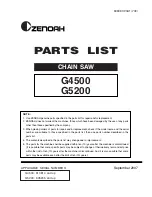
24
100642 - ChAiNSAw
MAiNTENANCE
The desired chain tensioning depends upon temperature of the
saw chain.
–
Cold Chain Tension - The chain should fit snuggly against the
underside of the guide bar. No sagging should be visible
(Fig. 26).
–
Warm Chain Tension - The steel blade expands when warm
due to use. Approximately 1/16 inch (1.3 mm) of sag should be
visible under the guide bar when warm (Fig. 26).
4. Wearing protective gloves, hold the guide bar tip up and
move the saw chain back and forth along the guide bar
(Fig. 27). Make sure the saw chain moves freely and is
properly meshed with the sprocket. If the saw chain does
not move easily, slowly turn the chain-tensioning screw
counterclockwise to loosen the saw chain. The saw chain will
not move if the chain brake is engaged.
5. Hold the guide bar tip up and securely tighten the two 13 mm
clutch housing nuts.
CAUTiON
If the saw chain was tensioned while warm, it may become too
tight when cooled. Loosen the chain tension after operation
and check the chain tension before the next use.
Flats
Drive Links
Guide Bar
Figure 24
Figure 25
Correct cold tension
Correct warm tension
Too loose
Figure 26
Figure 27
ImPORTaNT: It is very important to maintain the proper chain
tension. Rapid wear of the guide bar or the chain coming off
easily can be caused by improper tension. Especially when
using a new chain, take good care of it since it should expand
during first use.
Removing and installing the Guide bar and
Saw Chain
CAUTiON
The guide bar, saw chain, and saw bearings will wear more
rapidly if the saw chain is not properly tensioned. Maintaining
proper chain tension will improve cutting performance and
prolong the life of the saw chain.
wARNiNG
The saw chain is very sharp. Always wear heavy-duty
protective gloves when handling or performing maintenance on
the saw chain.
The guide bar and saw chain need to be removed when certain
maintenance procedures are performed, such as when rotating
the guide bar. When replacing old guide bars and saw chains with
new parts, always use the manufacturer’s specified replacement
parts.














































